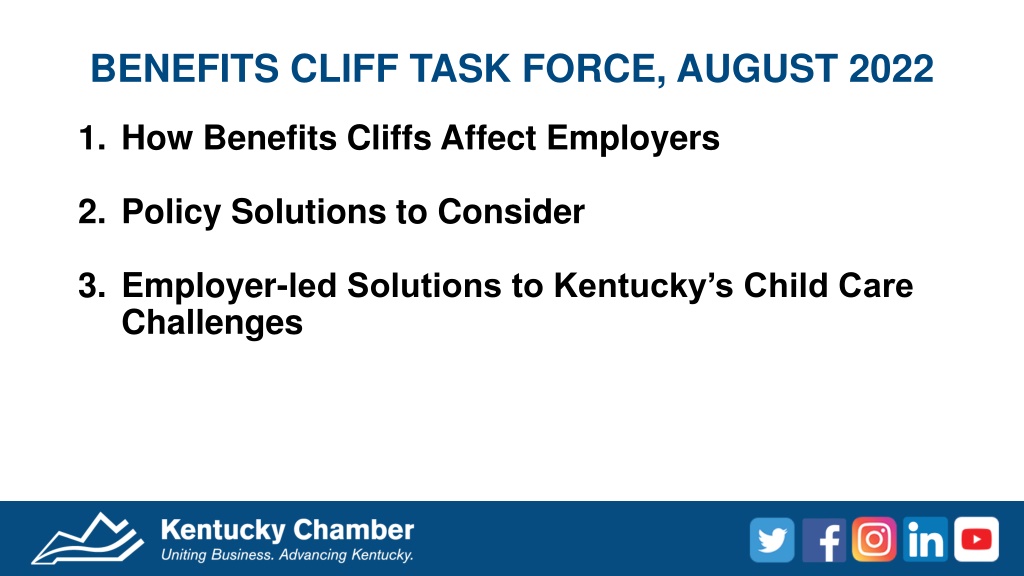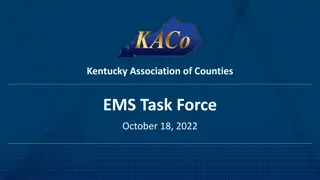Addressing Benefits Cliff Challenges in Kentucky Workforce
Employers in Kentucky are facing challenges due to benefits cliffs, especially in attracting and retaining employees amidst a tight labor market. Policy solutions and employer-led initiatives are crucial in combating these issues, including innovative programs like the Benefits Cliff Calculator and Public-Private Partnerships. Bridging the information gap and implementing collaborative strategies can help mitigate the impact of benefits cliffs on employers.
Download Presentation

Please find below an Image/Link to download the presentation.
The content on the website is provided AS IS for your information and personal use only. It may not be sold, licensed, or shared on other websites without obtaining consent from the author. Download presentation by click this link. If you encounter any issues during the download, it is possible that the publisher has removed the file from their server.
E N D
Presentation Transcript
BENEFITS CLIFF TASK FORCE, AUGUST 2022 1. How Benefits Cliffs Affect Employers 2. Policy Solutions to Consider 3. Employer-led Solutions to Kentucky s Child Care Challenges
BENEFITS CLIFF CHALLENGES TO EMPLOYERS Two primary ways in which benefits cliffs create challenges for employers 1. Offering an employee a wage increase 2. Offering an employee more hours or a transition from part-time employment to full-time employment Increased frequency in hearing about these challenges due to unprecedented labor market tightness
BENEFITS CLIFF CHALLENGES TO EMPLOYERS Key Benefits Cliff Challenges for Employers: Increasing compensation to attract and retain employees Offering more hours or offering an opportunity to transition from part-time to full-time Long-term challenge Exacerbated by a historically tight labor market Policy solutions to consider
BRIDGING THE INFORMATION GAP House Bill 708 A Benefits Cliff Calculator that Works for Families and Employers Emphasize user-friendliness Clearly illustrate pathways to self-sufficiency Integrate into tools already being utilized by recipients Provide technical and coaching support services
PUBLIC-PRIVATE PARTNERSHIPS Help Employers be part of the Solution House Bill 499: Employee Child Care Assistance Partnership How it works Potential Benefit Cliff Impact Single parent of a two-year old: $44k to $45k (85 percent SMI) $468 per month net loss ($5,616 per year/KY STATS FRS) IF their employer is an HB499 Employer with a $200 per month benefit = $68 per month loss (w/ $200 state match) State match would continue to phase down as earnings increase
THE EARNED INCOME TAX CREDIT Low-income earners Refundable Favors workers w/ children Nonparent max: $538 1 child max: $3,584 2 child max: $5,920 3+ child max: $6,660 Phases-in/phases-out Paid out in a lump sum Strong track record
THE EARNED INCOME TAX CREDIT The Earned Income Tax Credit (EITC) is the cornerstone anti-poverty policy for families with children in the United States. Designed to fight poverty by encouraging and rewarding work, decades of research on the EITC has found that the program meets its goals by increasing employment among targeted women, and by successfully raising their annual incomes, lifting millions of families out of poverty. This paper confirms and extends that consensus. Dr. Michael Strain, Director of Economic Policy Studies, American Enterprise Institute, Employment Effects of the Earned Income Tax Credit: Taking the Long View, November 2020
HOW KENTUCKY CAN LEVERAGE EITC Increase utilization rates KY EITC Utilization Rate (2018): 79.9 percent 380,000 filers, $943m ($2,450 per filer average) 100 percent = 475,000 filers, $1.178b How to increase utilization rates Engage CHFS to increase awareness of EITC among benefit recipients Engage DOR to increase awareness of EITC among low-to- moderate income tax filers
CHILD CARE & THE WORKFORCE CRISIS Bipartisan Policy Center Polling 68 percent: child care affected my ability to stay in the workforce 66 percent: child care affected my ability to work more hours 20 percent: quit a job to stay at home with a child KY Chamber Employer Survey Data 56 percent: Too many people in our region struggle with child care issues that keep them from working. Census Bureau Household Pulse Survey Not working because of care for children not in school or daycare in Kentucky 45,981 58.2 <> 59.5 Labor Force Participation
HOW EMPLOYERS ARE RESPONDING On-site child care availability Partnerships with local centers Partnerships with CCR&Rs Multi-employer child care services House Bill 499 Flexible schedule Remote work
CONTINUING CHALLENGES General child care availability Unexpected closures or changes in hours (due to staffing) Non-traditional work schedules Child care deserts Costs Competition with other benefits
KY CHAMBER: POLICY CONSIDERATIONS Ensure the Success of House Bill 499 Stabilize the Child Care Assistance Program (CCAP) Study Local Zoning Ordinances Ensure the Success of the Business Partnerships Grants Program The Employer-Provided Child Care Tax Credit (The Child Care Facilities Tax Credit) Fund the Early Childhood Development Scholarship























